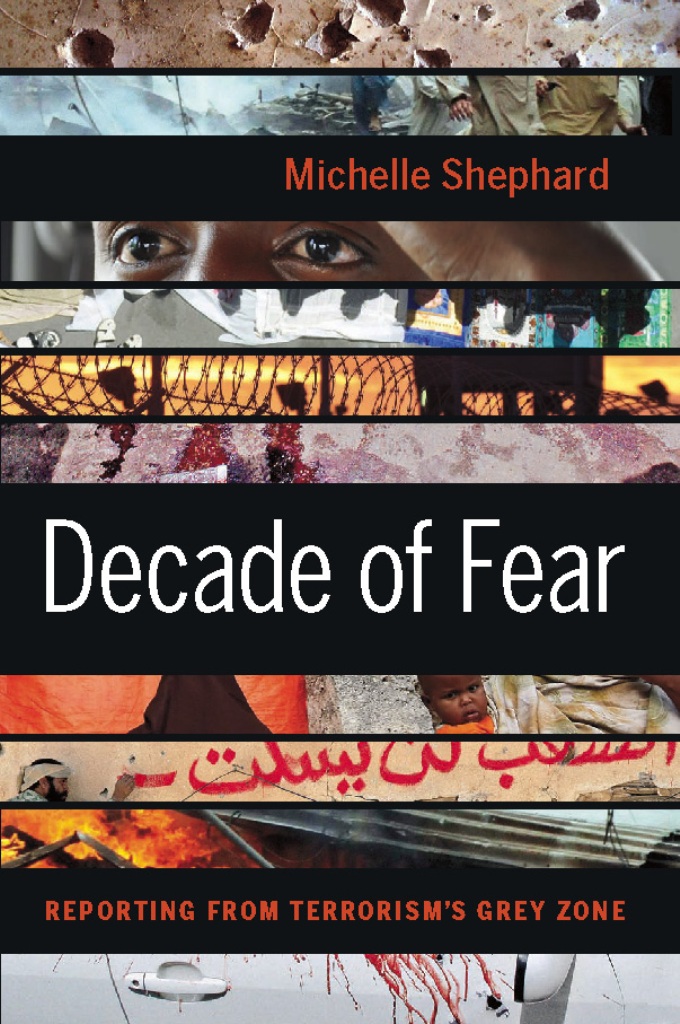Decade of Fear
Michelle Shephard
Decade of Fear
REPORTING
FROM TERRORISM’S
GREY ZONE
Copyright © 2011 by Michelle Shephard
All rights reserved. No part of this book may be reproduced, stored in a retrieval system or transmitted, in any form or by any means, without the prior written consent of the publisher or a licence from The Canadian Copyright Licensing Agency (Access Copyright). For a copyright licence, visit www.accesscopyright.ca or call toll free to 1-800-893-5777.
Douglas & McIntyre
An imprint of D&M Publishers Inc.
2323 Quebec Street, Suite 201
Vancouver BC Canada V5T 4S7
Cataloguing data available from Library and Archives Canada
ISBN 978-1-55365-658-6 (cloth)
ISBN 978-1-55365-659-3 (ebook)
Editing by Trena White
Jacket design by Jessica Sullivan
Jacket photographs (top to bottom): 1. Warrick Page/Getty Images News/Getty Images; 2. AFP/ Getty Images; 3. Michelle Shephard/ Toronto Star; 4. Michelle Shephard; 5. Michelle Shephard/Toronto Star; 6. Rizwan Tabassum/AFP/Getty Images; 7. AFP/ Getty Images; 8. AFP/Getty Images; 9. same as #2; 10. same as #6 Distributed in the U.S. by Publishers Group West
We gratefully acknowledge the financial support of the Canada Council for the Arts, the British Columbia Arts Council, the Province of British Columbia through the Book Publishing Tax Credit and the Government of Canada through the Canada Book Fund for our publishing activities.
To Ismail, my hero and To Jimmie, my love
Contents
SOMEWHERE AT SEA: AN INTRODUCTION
5 U.S. NAVAL BASE, GUANTANAMO BAY
8 THE ARAB AWAKENING: BACK TO GROUND ZERO
“When the going gets weird, the weird turn pro.”
HUNTER S. THOMPSON
Somewhere at Sea: An Introduction
ELEVEN FLOORS ABOVE the churning Atlantic Ocean, with Fort Lauderdale long faded and the island of Grand Turk looming, former Central Intelligence Agency boss Porter Goss is justifying the waterboarding of self-professed 9/11 mastermind Khalid Sheikh Mohammed. He is using salted bar nuts as a prop.
We are on a mammoth Holland America cruise ship, sitting in a swanky bar called the Silk Den, which is serviced by solicitous Filipino wait staff who stand at ease with legs spread and hands clasped. Sitting to the right of the former spy chief is U.S. General Michael Hayden, the retired head of the American electronic eavesdropping agency, the National Security Agency, and Goss’s predecessor at the CIA. The New York Times once called Hayden the “thinking man’s spy.” Former U.S. president George W. Bush notes in his memoir: “Mike has a calming personality.”
To Goss’s left is Hayden’s wife Jeanine, who nods emphatically at each point made by the former spy bosses, sometimes adding comments, suggesting that perhaps she had been a domestic advisor of sorts. To her left stands Porter Goss’s forty-something-year-old son Chauncey, a mild-mannered fiscal policy consultant who acts as an awkward sentry for our group, appearing as though he will quickly extricate his father if the waiters, or my questions, become threatening.
Over the decade that I have covered terrorism and national security for the Toronto Star, dozens of moments have seemed so bizarre that I later wondered if I had somehow imagined them. This November 2010 evening aboard the “Spy Cruise” is one of those times.
Themed cruises are common enough. Mickey Mouse and Donald Duck have their sea legs. Fitness wannabes Cruise to Lose and gyrate to Richard Simmons before the buffet. Even Elvis impersonators can indulge their passion on the ocean (can you imagine the “Thank Yous” at the buffet line?). So why not mix terrorism and tourism?
Why not, asked Bart Bechtel as he created his SpyCruise® series after 9/11. SpySkipper Bart, as he likes to be called, is a true red-white-and-blue-bleeding patriot who worries that Americans may forget the horror of 9/11 and become complacent in their security fears. Bart was once a CIA operations officer, recruited when he was working in a California liquor store in the 1970s. “I thought, if I can sell a bottle of Jack Daniel’s, I can sure as hell sell America,” he told me on more than one occasion.
I had just returned home from my twenty-third trip to Guantanamo Bay when a friend sent me an email about cruising the western Caribbean. The idea of two former intelligence heavyweights trapped aboard a ship, not to mention the vaudevillian idea of cruising with spies, was too much to pass up.
On the ship of about a thousand passengers, there were only about a hundred of us “spy cruisers”—an eclectic mix of intelligence types, students, “consultants” (including one odd, raspy fellow who warned that if I wrote about him there would be “consequences,” even though I was just making small talk because I felt bad he was sitting alone), and some very sharp and genial retirees. We were given little pins with the U.S. Secret Service symbol embedded into an American flag.
During the days at sea, we sat in a stuffy third-floor conference room listening to terrorism talk, as coffee sloshed back and forth in our china cups from the unusually high swells. On breaks, we discussed the Patriot Act, the trouble with Iran and whether those discreet seasick-remedy patches behind our ears actually calmed the queasiness. In the evening “off-hours,” or at port stops, we were free to be tourists. It always seemed awkward running into the speakers. Stumbling upon Hayden on the Lido deck in his sandals and khaki shorts as he dined with his wife, while bikini-clad cruisers got drunk in a nearby hot tub, somehow felt voyeuristic.
Hayden and Goss were not thrilled that three reporters were on board, but they were generous with their time and had agreed to meet us in the Silk Den that evening. For most of the meeting my friend Colin Freeze, who covers national security for the Globe and Mail, was on the edge of his seat, leaning forward, with a big mischievous grin and his fingers constantly running through his curly blond hair as he talked. Colin was extremely knowledgeable about terrorism issues and had a thirst for security information
